VIVA LA RÉUNION
Bouchons, chouchou and ‘pineapple surprise’ – a taste of France in Africa
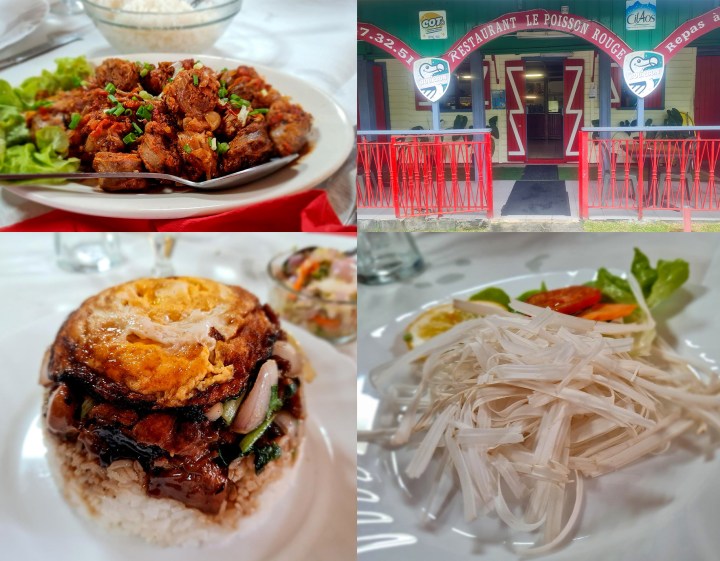
Réunion is as French as baguettes and croissants, yet as foreign as can be. The food of this volcanic island, like its inhabitants, is a fascinating mixture of East and West, Europe and Africa and Asia, with a touch of Gallic je ne sais quoi to spice things up.
After spending more than half of my adult life in France, exploring most of its magnificent cities and many of its charming towns, I’m still intrigued by the fact that five of the 101 départements of the country are actually thousands of kilometres from mainland France.
Apart from all the former colonies and territories that have become independent countries, like Senegal or the Ivory Coast, Madagascar or Mauritius, there are a few tiny islands and a place called French Guiana in South America that are still part of France.
Réunion is one of these départements d’outre-mer or overseas departments where French laws are applied, including a maze of administrative laws dating from Napoleon’s time. But if you have to deal with French administration, it is probably less painful to do so under a palm tree close to a tropical beach than in metropolitan France. This seems to be the philosophy of our friends, Mario and Yvette, who have been living in Réunion for three decades – and have been urging us to visit them for almost as long.
La Réunion, as everyone in France corrects me whenever I refer to Réunion – making it sound like The Island of all islands – is a dot in the Indian Ocean, east of Madagascar and southwest of Mauritius. South Africans have favoured Mauritius for glamorous island holidays ever since Sol Kerzner opened his first hotel there in the Seventies, but most of them fly right over Réunion on their way to Mauritius without ever exploring this less-glamorous, less-touristy island option.
When we finally took up our friends’ longstanding invitation this summer, we encountered quite a number of tourists, but with the exception of a solitary Japanese hiker, they were all from mainland France or from French-speaking parts of Belgium, Switzerland or Canada. The only language we heard around us was French – or Creole based on French – but please don’t let that deter you from discovering Réunion if you don’t speak French. The staff of most hotels, restaurants and tourist spots will at least try to understand English, and what they lack in language skills they make up for in smiles, warmth and friendliness.
In fact, whenever I stopped noticing the rainforests and palm trees and started imagining that I was in la metropole, as mainland France is called over here, I was brought back to my senses by all the smiling faces. In the European part of France people don’t smile that easily. Réunion might be French, officially, but its spirit is more African, just as its food is more spicy and served much more generously.
None of those little culinary artworks on a plate, one plate after the other, which somehow still leave you feeling empty at the end of a meal in a fancy French restaurant. Here you get a single plate piled with food, often with enormous quantities of rice, which reminded me of my Afrikaans family’s traditional Sunday meals.
Our friends wanted to share all the highlights of the island with us, every scary mountain pass and every spectacular waterfall, every breathtaking sea view and every taste of fish, fowl or exotic fruit. In short, every experience they’d enjoyed during 30 years on the island they wanted to shower on us in a single week. Which meant that we were hiking and swimming and snorkelling and eating – oh, lots of eating – almost from the moment our plane touched down in the capital of St-Denis up to an hour before we flew out again.
I had a vague idea of spending hours stretched out on a beach with a cool drink and a hot book, maybe a few palm trees swaying in the background – the mental picture inevitably associated with a lazy Indian Ocean island holiday – but within an hour of arriving I was tramping up a mountain to watch the sun rise over an amphitheatre formed by volcanic eruptions. And the fact that the beach dress and sandals I’d worn on the plane were completely unsuitable for a mountain trail and the icy temperatures at this altitude was forgotten as soon as I saw the view.
This was the first of many surprises, and by the time I finally did get to a beach much later that day to watch the sun set in an orange glow over the ocean – after more hiking, driving, outdoor picnics and a session of snorkelling among multicoloured tropical fish – I knew that this would definitely not be a lazy lounging-on-the-beach type of island holiday. But by then I was wondering who would want to lie on a beach all day when there is such an astonishing variety to see and do and taste on this little island.
Réunion is barely 60km long and 45km wide, but the landscape, fauna and flora, even the weather, differ from one region to the next. The west side, where our friends live, has lovely beaches with white sand and bleached scraps of coral, while the southeast side is covered with black lava rocks from the still frequent eruptions of the active volcano of Piton de la Fournaise.
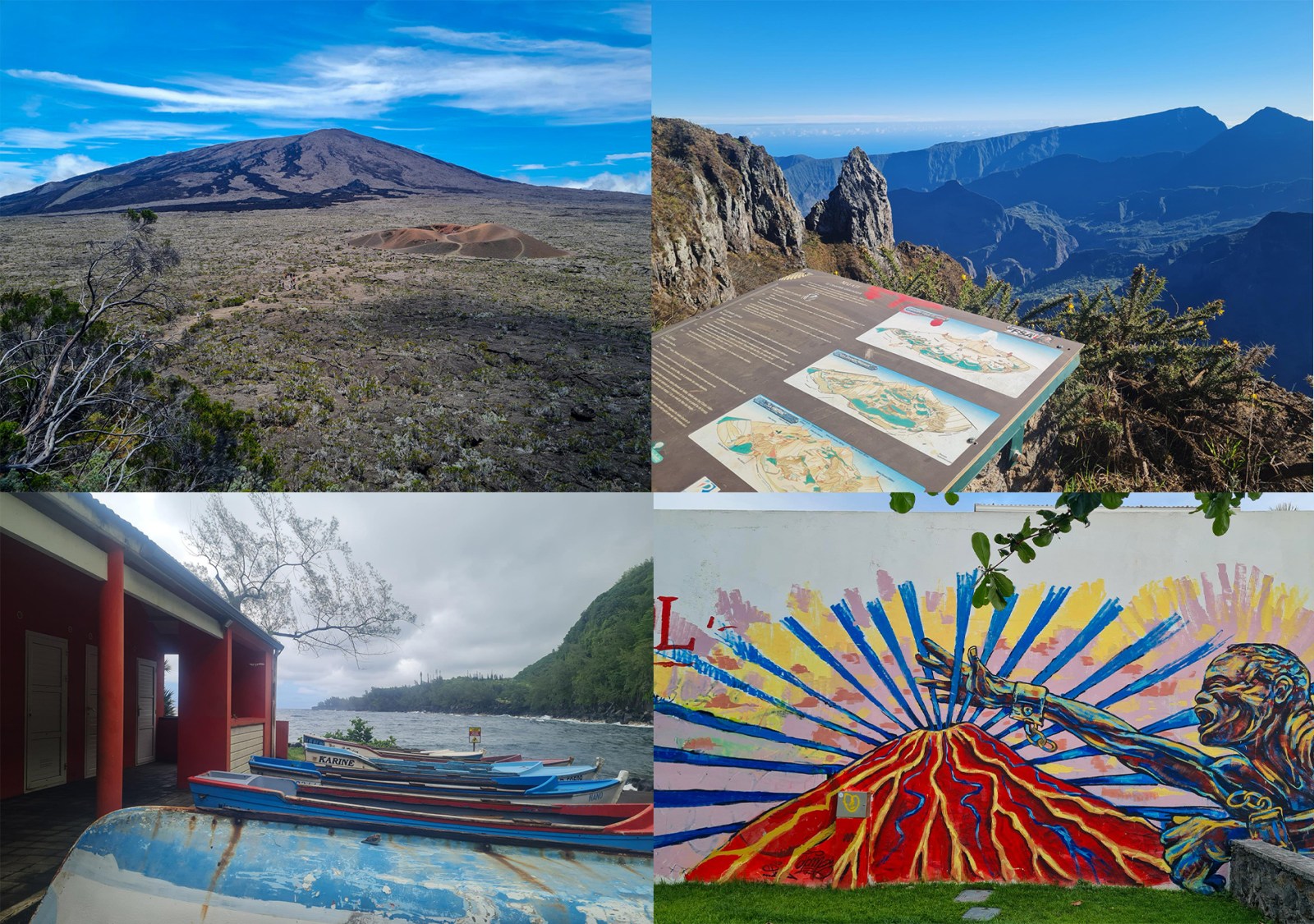
Clockwise from top left: the volcano of Piton de la Fournaise; paintings by local artists; one of many colourful wall paintings, and fishermen’s boats on the southeast coast. (Photo: Marita van der Vyver)
In the three cirques or amphitheatres formed by the inactive volcano of Piton des Neiges, there are rainforests and waterfalls, hot-water springs and sugar plantations and even vineyards producing wine. And then there is the contrast of the bare, moonlike landscape around the active volcano, which can only be reached after descending hundreds of stairs built into a cliff.
Of course you’ll have to haul your reluctant body up all those stairs again, as I did, complaining all the way. That’s when I had enough breath left to complain. But I wouldn’t have missed the experience for all the breath in the world – and Mario and Yvette, being French and knowing that nothing can lift the spirit like a good meal, booked lunch for us at an excellent restaurant close to the volcano.
O’QG, a playful abbreviation meaning “At the Headquarters”, with colourful walls decorated with paintings by local artists, a chef from Senegal, an impressive collection of wines, and a menu offering classical French, African and Réunion dishes, is a perfect example of the island’s cultural and culinary fusion.
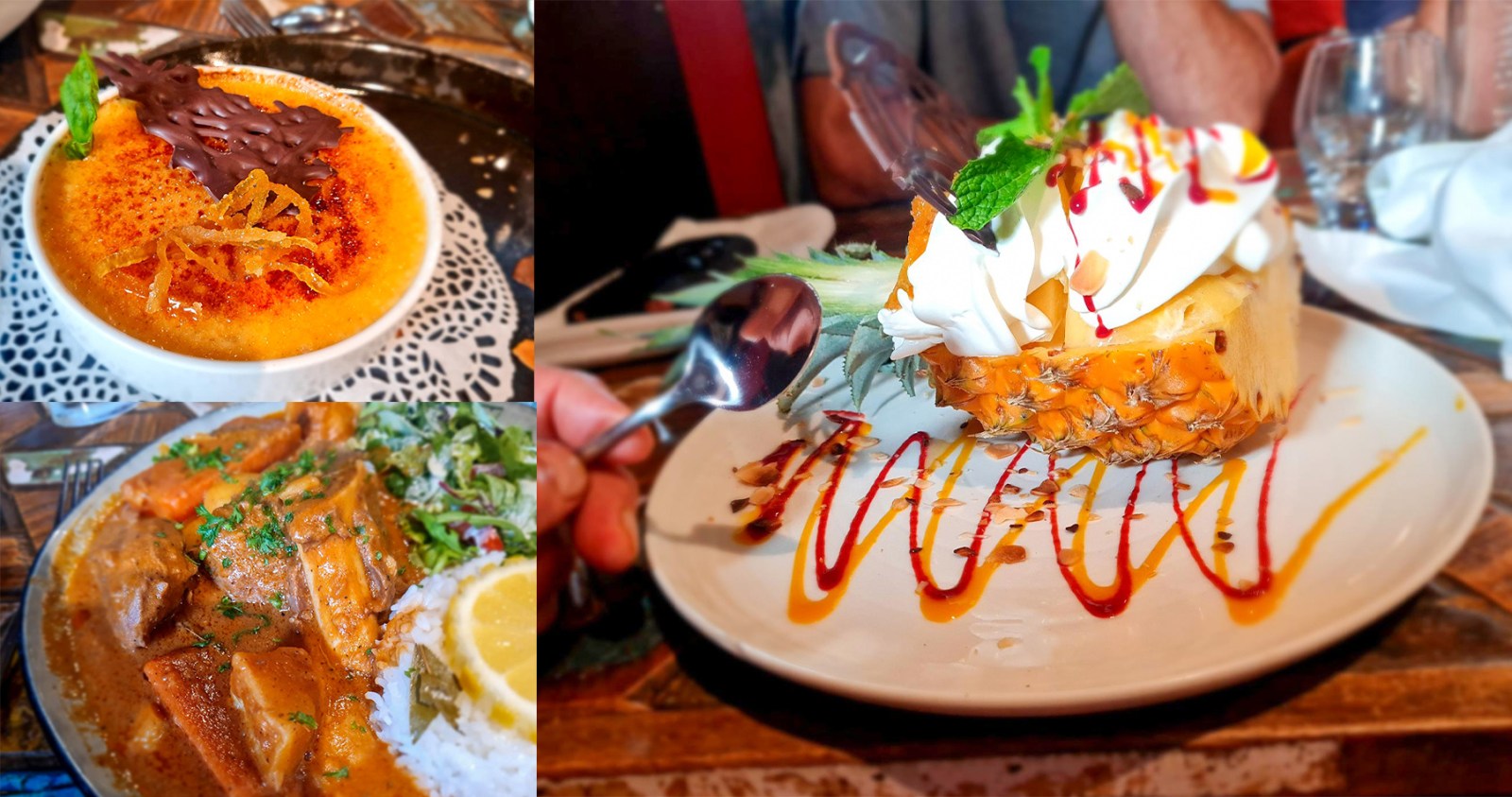
Clockwise from top left: crème brulée made with Bourbon vanilla; ‘pineapple surprise’, and mafe from Senegal, a beef stew. (Photos: Marita van der Vyver)
I chose the mafe from Senegal, a hearty stew of beef simmered in a tomato and onion sauce with peanut butter, garlic, ginger and other spices added, while my partner went straight for the carry, which is the Réunion version of Asian curry. Since this partner would sell his birthright for a plate of hot and spicy food, he spent the seven days of our stay in a seventh heaven of carry, rougail and other tongue-burning delights.
Rougail is probably the most well-known dish of Réunion – or at any rate the only one I’d eaten a few times in metropolitan France – so of course we had to try this spicy sausage and tomato stew while we were there. But we postponed our plate of rougail until the last day of our visit, because we were too curious about all the other dishes we hadn’t tasted anywhere else. Like the exotic “pineapple surprise” that we enjoyed as dessert at O’QG (almost a whole pineapple with whipped cream and fruit coulis in shades of red and orange) or the simple but luxurious heart of palm salad we had at another restaurant later in the week. And even classical French dishes like that old dessert favourite, crème brûlée, can acquire a local twist when it is made with the famous Bourbon vanilla of the Indian Ocean, only produced on the islands of Réunion, Madagascar, Mauritius, Seychelles and Comoros.
(A bit of history served on the side: Réunion was originally named Bourbon Island, in honour of the Bourbon dynasty, when the French colonised it in 1642. This is why many products, including the local beer, are still named Bourbon.)
Two days after our volcano expedition we explored the Lava Road on the rugged southeast coast. Since it was raining (apparently it is always raining somewhere on the island), we took refuge in the church of Sainte-Rose where a 20th-century miracle was supposed to have happened. The church hosts a statue of Mother Mary holding a shockingly modern-looking blue umbrella over her head – quite an anachronistic sight, especially if you’re not Catholic – because this Vierge au Parasol has long been protecting local people against volcanic eruptions. In 1977 the lava from yet another eruption flowed right around the church, but stopped at the church door, and up to today the pretty little building stands all alone in a sea of black lava rock.
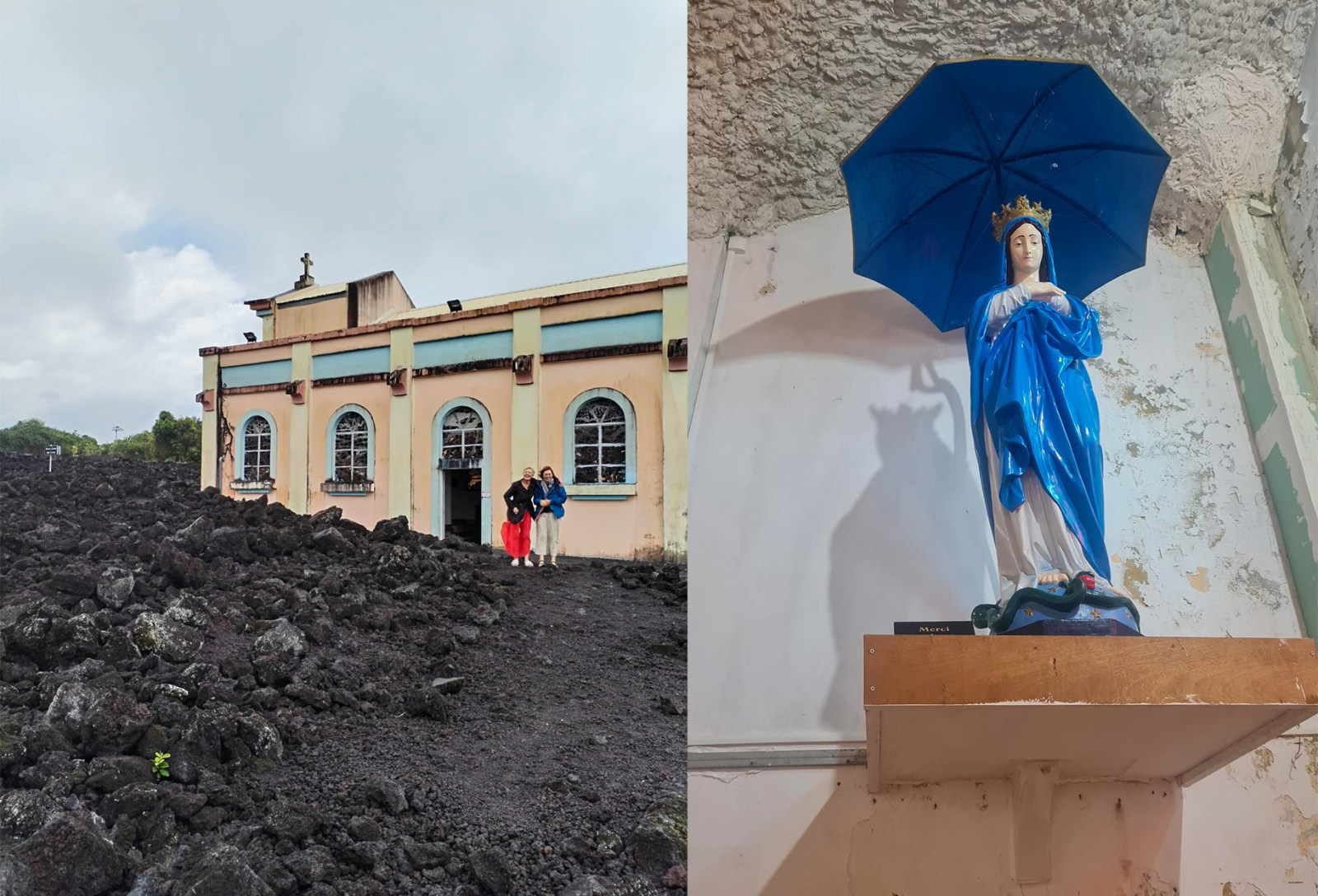
The Virgin with the Umbrella (right) and the little church surrounded by black lava rocks. (Photo: Marita van der Vyver)
The miracle has since been scientifically explained, but I’m not going to spoil a good story with science. Let’s just say, despite the widely held superstition that it brings bad luck to open an umbrella indoors, this holy umbrella seems to have the opposite effect.
An hour later we experienced the more mundane miracle of an exciting meal in an unpretentious family-run restaurant. Le Poisson Rouge offers a mix of French, Asian and Creole cuisine, with most of their signature dishes featuring heart of palm. After the palm heart salad as a starter, my curiosity led me to another Réunion standby, the bol renversé. Literally an overturned bowl of tightly packed layers of rice, chicken and prawns, mushrooms and other vegetables, all crowned with a fried egg. I was surprised by the egg, but once I tucked in, the combination of flavours and colours made perfect sense.
Among the vegetables in the upside-down bowl were brèdes, a catch-all word for the various local leafy greens often seen on plates in Réunion. That Saturday morning, at St-Paul’s weekly food market, we could admire many of these greens in their uncooked state, as well as the beloved chouchou or chayote, an avocado-shaped, courgette-like vegetable. Chouchou also happens to be a French term of endearment, something like “little darling”, which might be just another proof of the vegetable’s popularity.

Tropical fruits at the market of St-Paul and (inset) a sugared hibiscus flower. (Photos: Marita van der Vyver)
The market of St-Paul resembles France’s famous food markets in many ways – the artistic display of fruit and vegetables, the combinations of colours and the contrasts of shapes, the odours, the sounds – but you’ll also find gourmet delights typical of the island. Sweet-potato cakes, dried and sugared hibiscus flowers, coconut-milk sorbets, sugar-cane drinks, bunches of small green Réunion bananas, enormous pineapples, piles of shredded palm heart, red chilli peppers and green combavas (a citrus fruit related to lime), and a glorious variety of spices.
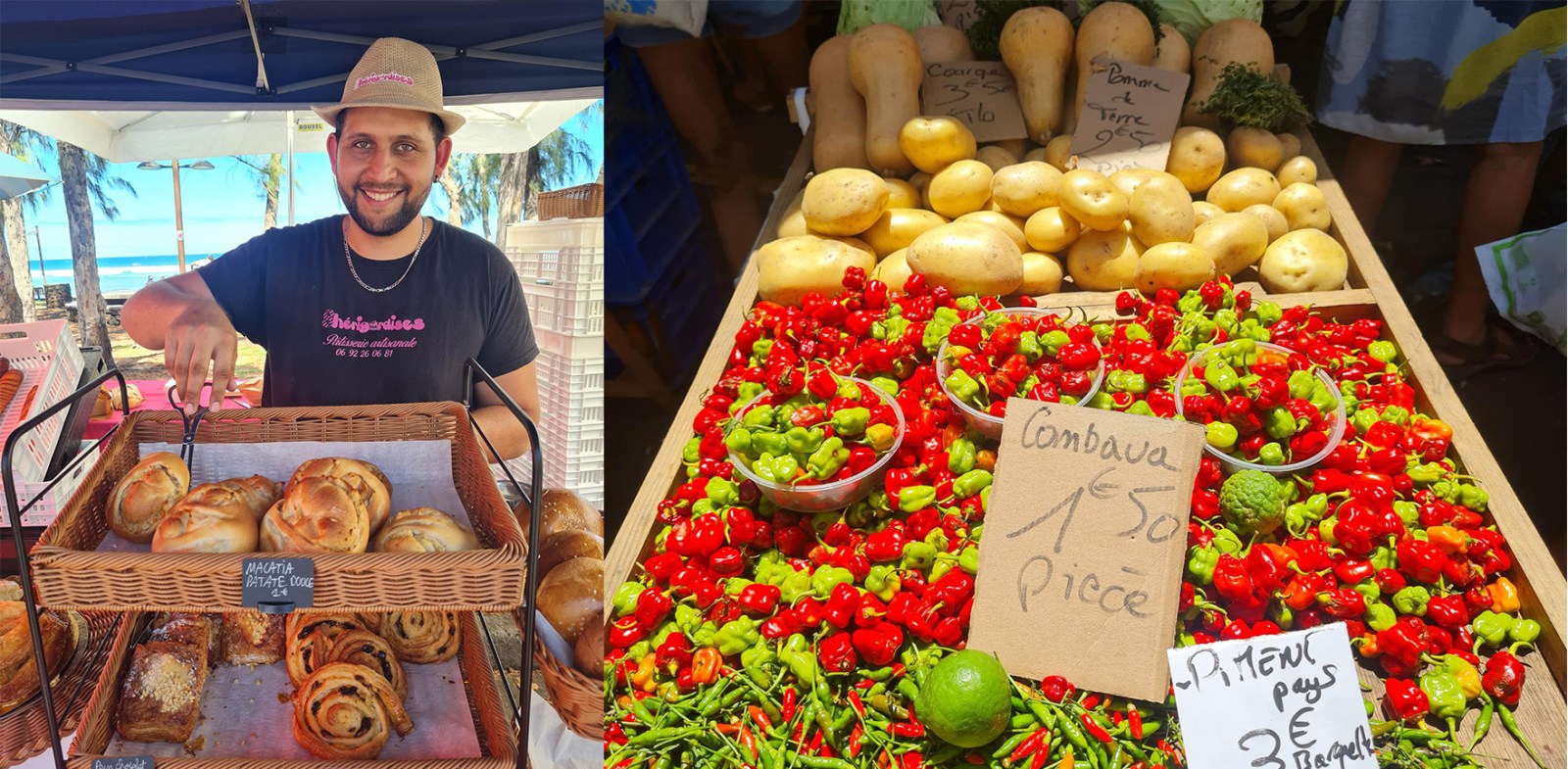
Traders sell chilli peppers and combavas, and sweet-potato cakes. (Photos: Marita van der Vyver)
After strolling through the market in a daze of tropical sensuality, you can enjoy a Bourbon beer and a plate of warm bouchons at a beach bar. Bouchons are steamed parcels of dough stuffed with pork or chicken, another irresistible island speciality. Oh, and the round buildings of the beach bars are called rondavelles, similar to the Afrikaans word for a bungalow, which once again surprised me.
We spent more than one early evening at these rondavelles, with our toes in the sand and our eyes on the horizon where the sun was sinking melodramatically into the sea.
Everyone’s favourite pastime at this hour is apparently to spot the elusive rayon vert which Jules Verne wrote about – the green flash that is sometimes visible at the exact moment the sun disappears in the ocean. I remember watching Eric Rohmer’s film, Le rayon vert, at the Labia in the late Eighties, but somehow I never really took this green flash seriously. That is until I found myself on the west coast of Réunion, where all the French-speaking tourists seemed obsessed with the phenomenon, staring so intently at the setting sun that you would think this was their main reason for visiting the island.
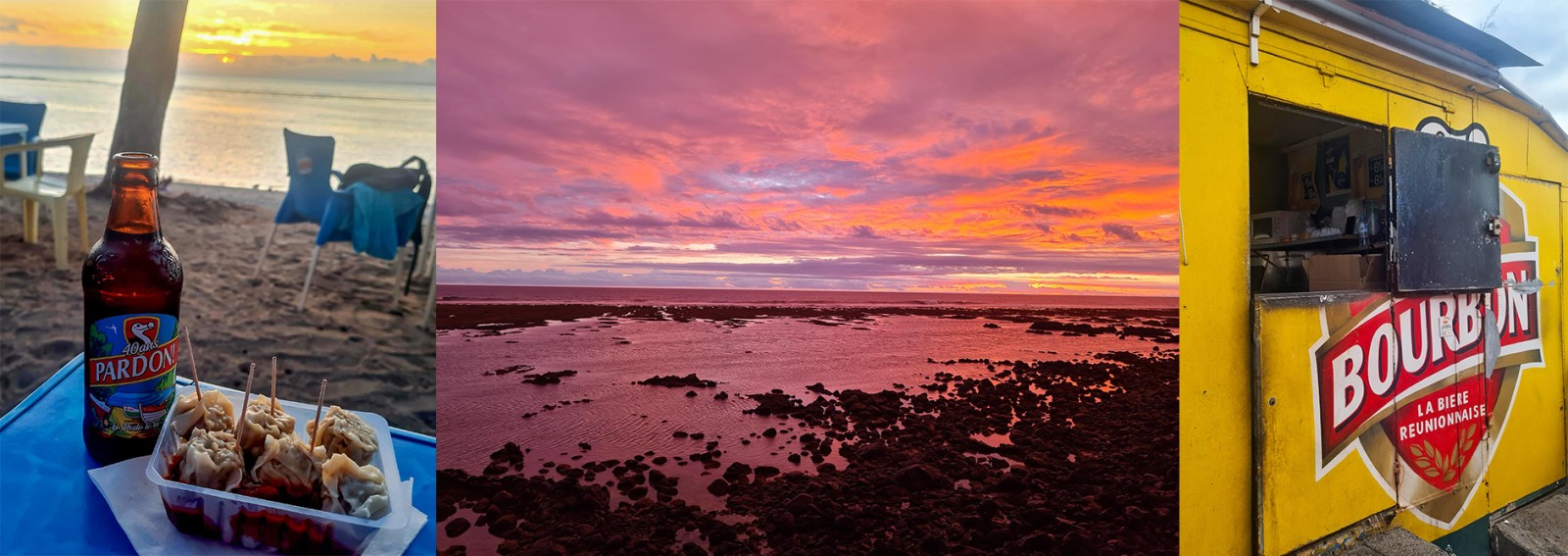
Bourbon, the beer of Réunion (left and right), flanking one of the island’s enthralling sunsets. (Photo: Marita van der Vyver)
So I started staring too, sipping my Bourbon beer, and voilà! I saw the green flash. Not once, but two evenings in a row. And no, there was no intoxication involved. The first time I hadn’t even finished a bottle of beer, and the second evening I drank tonic water to be absolutely sure I was seeing what I thought I was seeing.
Maybe it was just a case of “search and ye shall find”, or look and ye shall see, but to me it was proof that this is indeed an enchanted island. As we flew away and I watched the island shrinking below the plane, receding until it became just a small dot in the ocean again, I recalled the Bard’s words: Be not afeard, the isle is full of noises/ Sounds and sweet airs, that give delight and hurt not.
For who, after all, knows more about island enchantment than the author of The Tempest? DM






 Become an Insider
Become an Insider
Comments - Please login in order to comment.